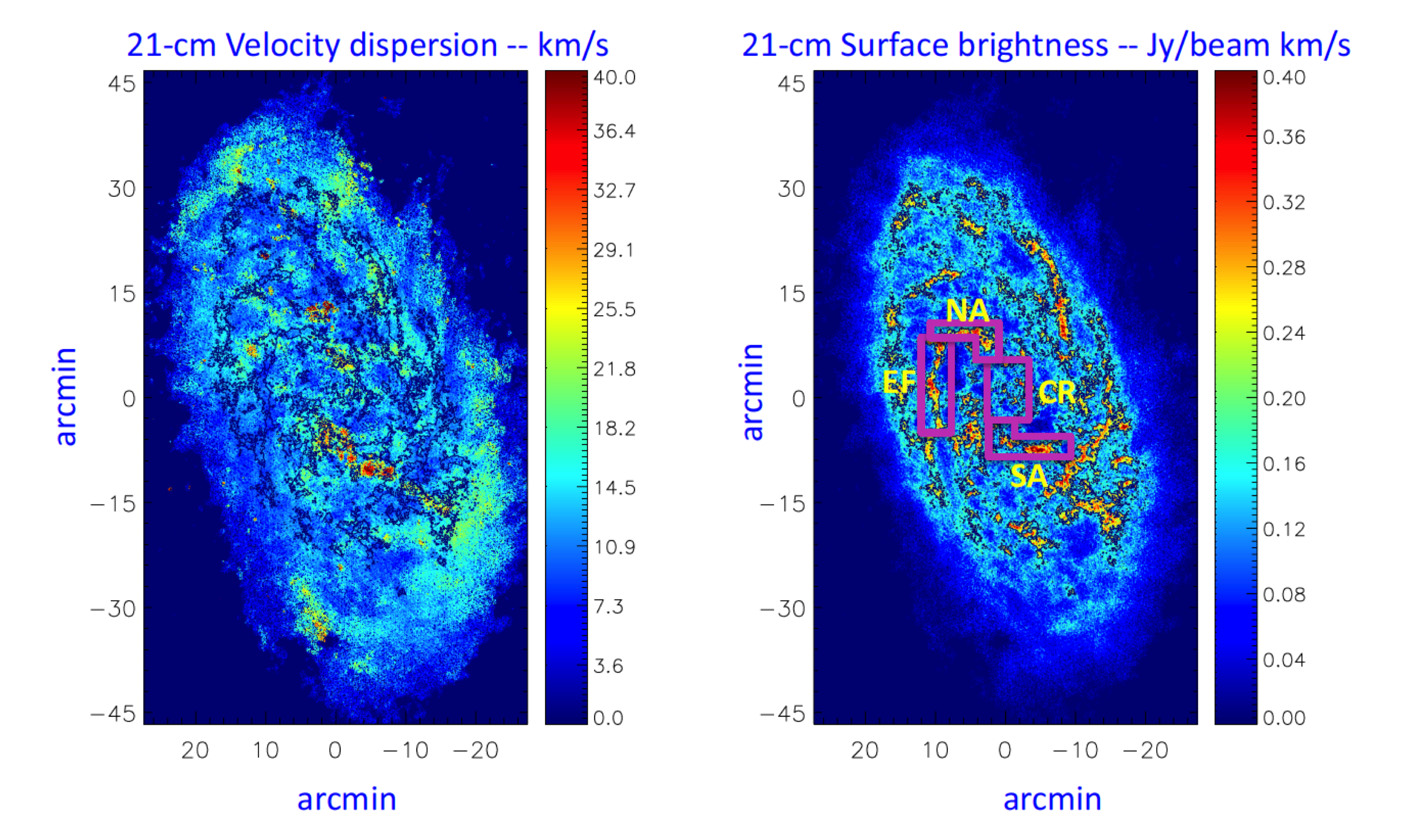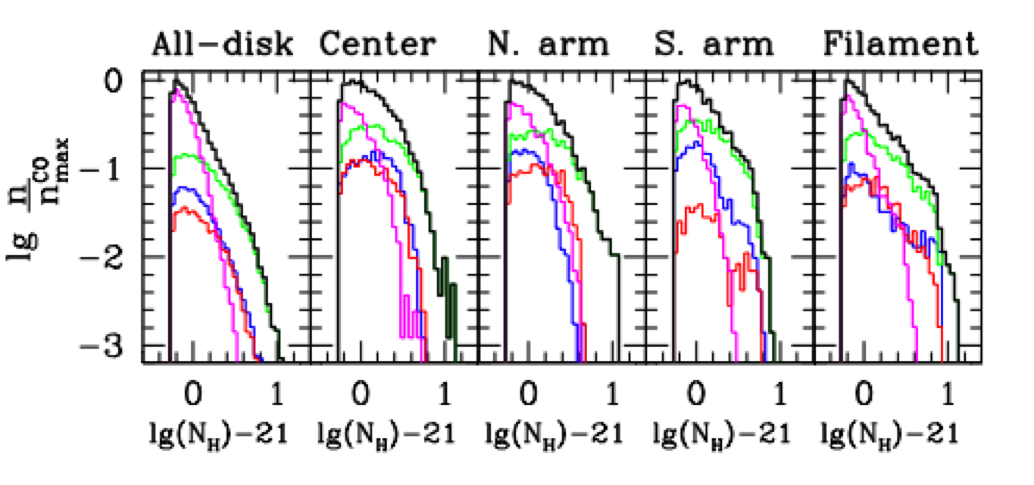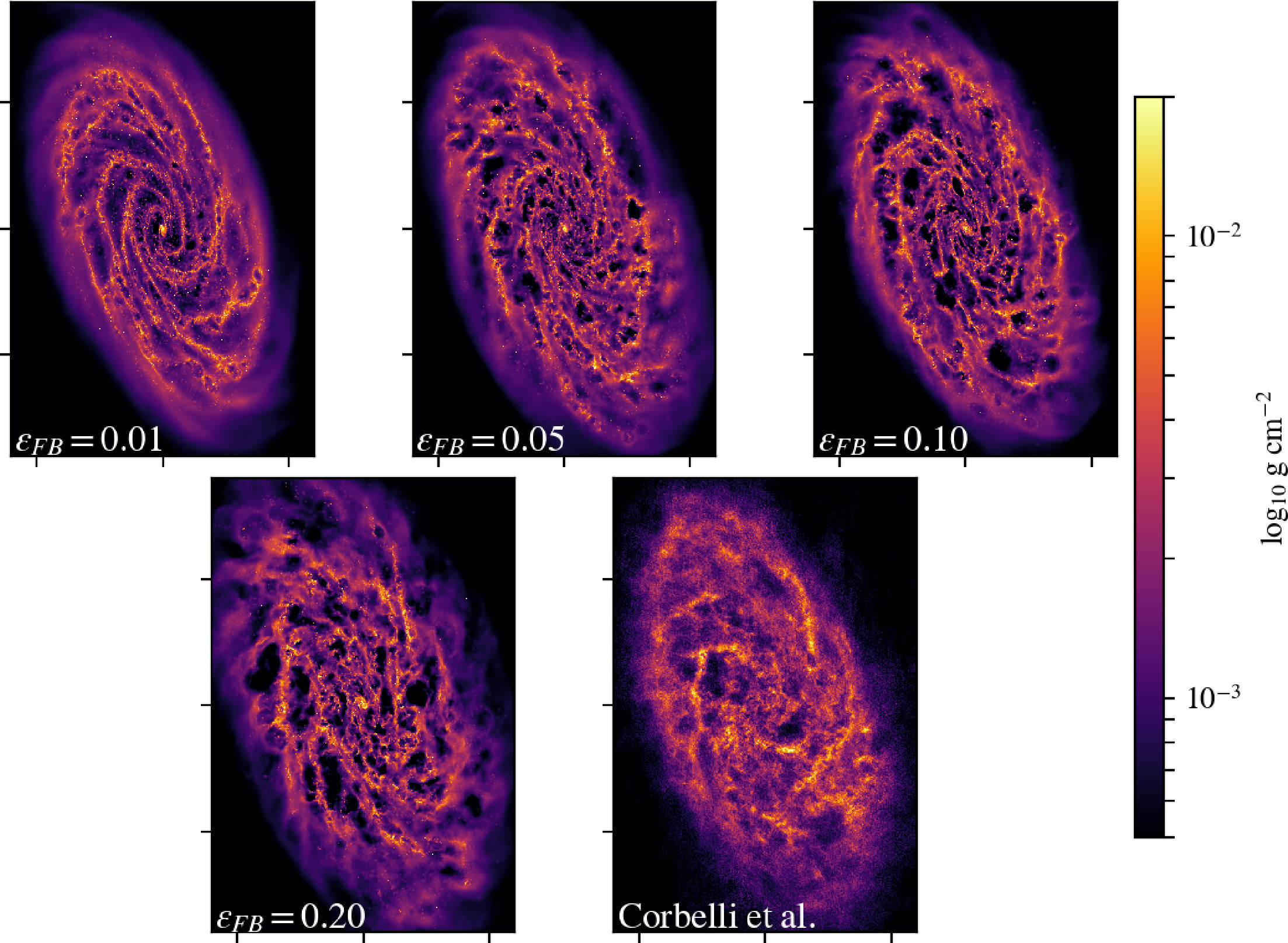Gravity versus feedback: shaping the gas distribution in M33
The Arcetri extragalactic group has always been active in investigating Local Group closest spirals, M31 and M33, performing measurements of dark matter halo properties, imaging and modeling their stellar and interstellar medium (ISM) constituents. Dark matter masses, together with proper motion data analysis, suggest that M33 is an undisturbed disk on its first approach to M31 with no sign of recent merging of satellite galaxies. Hence, this blue spiral galaxy is the closest laboratory to study the driving physical processes for spiral structure, gas fragmentation and star formation in isolated disks. A fundamental open question is related, for example, to the low star formation efficiency. This can be the result of localized small collapsing regions inside large clouds dominated by turbulence. Another possibility is that cloud complexes are collapsing on a much larger scale but feedback from newborn massive stars quenches star formation.
To shed light on the spatial scale of self-gravitating structures, a group of scientists led by Edvige Corbelli has recently investigated the shape of the probability distribution functions (PDFs) of the atomic, molecular and total gas surface density (Corbelli, Elmegreen, Braine, Thilker 2018) throughout the whole disk of M33. Numerical simulations have shown that compressible turbulence, driven by feedbacks, shapes the gas PDF as a log-normal function but, if self-gravity becomes dominant above a certain density in a cloud, the PDF develops a power-law tail. Hence, the lower limit to the power-law part of the PDF gives the average column density above which self-gravity becomes the main driving force of cloud evolution. The state-of-the-art spatial resolution and frequency coverage of recent ISM surveys have allowed Corbelli et al. (2018) to determine for the first time the average transition column density for several regions (defined in Figure 1) throughout a star forming disk, combining molecular and atomic data. The analysis has been performed also for separate sets of giant molecular clouds (GMCs), each representing clouds at a particular stage during their evolutionary sequence, as defined by Corbelli et al. (2017).
 |
| Figure 1: Velocity dispersion map of the atomic hydrogen 21cm line emission in M33 at 10 arcsec resolution (left panel). The black contours underline the location of the bright HI filaments or arms. These contours are overlaid also on the surface density map in the right panel where the magenta boxes indicate regions selected for this study: the central region (CR), the northern arm (NA), the southern arm (SA), the outermost filament to the east (EF). Figure from Corbelli et al. (2018). |
The average velocity dispersion of the atomic gas in M33 (Figure 1) is radially constant with values on the order of 13 km/s suggesting a ubiquitous presence of feedback driven turbulence. The high pressure and rate of star formation in the central region shapes the PDFs as log-normal functions for all gas components. GMCs prior and during star formation in the central region and in the northern arm are dominated by turbulence and intense feedback at all column densities that are spatially resolved. In the southern arm and especially in the outermost filament rich in molecules, large departures of the molecular gas PDF from a log-normal shape are found, with power-laws detected for column densities above 1021 H atoms/cm2 (see Figure 2). This, combined with cloud maps, suggests a stratification of density within molecular cloud complexes, compatible with the dominance of self-gravity at all evolutionary stages in these regions. Moving radially outwards in the disk, gravity takes over turbulence on larger scales, likely because turbulence becomes subsonic as suggested by the decreasing PDF width and by cloud models discussed in detail in the paper.
 |
| Figure 2: PDFs of the molecular gas column density in units of H atoms/cm2 for the total molecular gas (black heavy curves), and for the gas in three GMC types: non-star forming (red lines), with embedded star formation (blue lines), and with exposed star formation (green lines).The PDF for diffuse molecular gas (meaning low-mass clouds or truly diffuse) is marked in magenta (see Corbelli et al. 2018 for more details). All PDFs have been normalized to the number of pixels at the peak. The panels correspond to the all-disk and to different regions in the galaxy. Figure adapted from Corbelli et al (2018). |
The role of feedback and gravity in driving ISM structures in M33 has been also investigated numerically using smoothed particle hydrodynamics simulations by Dobbs, Petit, Corbelli and Pringle (2018). This study has shown for the first time that gravitational instabilities in the stars and gas are able to drive the formation of filamentary spiral arms in the ISM of isolated disks. However, to reproduce in detail the flocculent spiral pattern and the prominent holes observed in the atomic gas of M33, a sufficiently high stellar feedback efficiency is needed as can be seen in Figure 3. Data analysis and models of M33, the closest undisturbed spiral galaxy, clearly show the delicate balance between gravity and feedback at all scales during galaxy evolution.
 |
| Figure 3: Atomic gas surface density according to best fitting simulated models for different levels of feedbacks compared to the observed M33 atomic gas distribution by Corbelli et al. 2014 (lower right). Figure from Dobbs et al (2018). |
References:
Corbelli, E., Thilker, D., Zibetti, S., Giovanardi, C., and Salucci, P., 2014, A&A 572, 23
Corbelli, E., Braine, J., Bandiera et al. 2017, A&A 601, 146
Corbelli, E., Elmegreen, B. G., Braine, J., and Thilker, D., 2018, A&A in press
Dobbs, C. L., Petit, A. R., Corbelli, E., and Pringle, J. E. 2018, MNRAS, 478, 3793
Edited by E. Corbelli and A. Gallazzi



